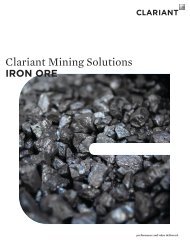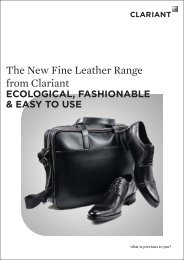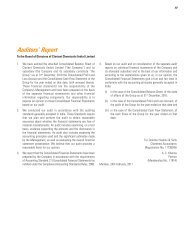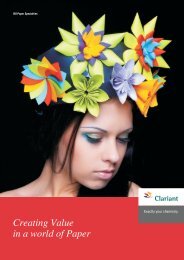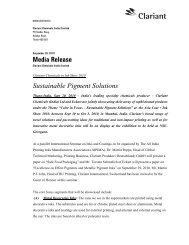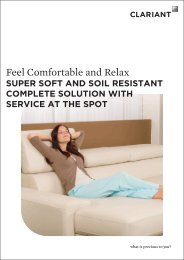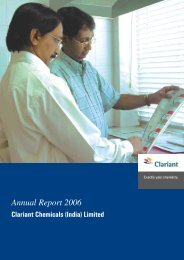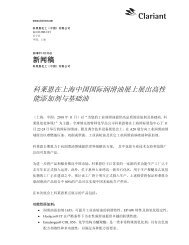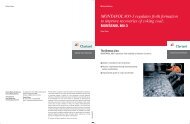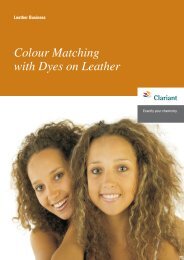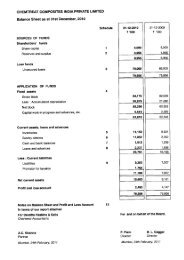Colour Chronicle - April 2012 - Clariant
Colour Chronicle - April 2012 - Clariant
Colour Chronicle - April 2012 - Clariant
Create successful ePaper yourself
Turn your PDF publications into a flip-book with our unique Google optimized e-Paper software.
Sheet (MSDS), prepared according<br />
to an applicable recognized norms<br />
or directive. (ANSI Z400.1 -2004,<br />
1272/2007/EEC,ISO 11014-1,2001/58/<br />
EEC, GHS, and JIS Z 7250:2005,<br />
Part-1).<br />
Following are strictly prohibited:<br />
Chemical inputs containing aromatic<br />
and chlorinated solvents<br />
Surfactants nonyl and octylphenols,<br />
their ethoxylates (NPEOs) and APEOs,<br />
LAS, alpha-MES<br />
Inputs containing functional nano<br />
particles (particles with a size 1-100<br />
nm)<br />
Genetically modifi ed Organisms<br />
(GMO’s) and their derivatives including<br />
enzymes derived from genetically<br />
modifi ed organisms<br />
Complexing agents like EDTA,DTPA,<br />
NTA<br />
Formaldehyde and other short-chain<br />
aldehydes (aldehydes up to 6 carbon<br />
and both momo- and dialdehydes are<br />
considered as “short chain aldehydes)<br />
The use of synthetic sizing agents is<br />
restricted. Knitting and weaving oils<br />
must not contain heavy metals.<br />
No chlorine containing bleaching<br />
agents permitted. Bleaches must be<br />
based on Oxygen.<br />
Fluorocarbons such as PFOS, PFOA<br />
Organotin compounds such as<br />
DBT,MBT,TBT,DOT,TPhT<br />
Plasticizers such as Phthalates,<br />
Bisphenol A and all other ones which<br />
are potentially endocrine disruptors<br />
Polynuclear hydrocarbons (PHA)<br />
All the chemical inputs must be ‘heavy<br />
metal free’ with the exceptions of Dyes<br />
and Pigments containing metals with<br />
restricted values.<br />
Azo dyes that releases carcinogenic<br />
amines upon cleavage. The limit value<br />
for aryl amines on fabric has been<br />
revised to 20 from 30 mg/kg in new<br />
version.<br />
Disperse dyes classifi ed as allergenic<br />
Pigments that releases carcinogenic aryl<br />
amines (MAC III category 1,2 & 3)<br />
Chlorophenols (PCP, TeCP etc.)<br />
including their salts and esters<br />
Though the total ban on Quaternary<br />
Ammonium Compound are is dropped<br />
DTDMAC, DSDMAC & DHTDMAC<br />
are banned.<br />
Similarly, ban on biocides used as<br />
“In-can” preservatives has now been<br />
dropped, still they are banned in<br />
fi nishing.<br />
The limit value for AOX has been<br />
changed from 0.5 to 5.0 mg/kg in new<br />
version.<br />
pH levels for products with skin contact<br />
has been limited to 4.5 – 7.5<br />
Limit value for tin, TphT, DOT,PAH,<br />
and Phthalates as well as Cadmium<br />
and Lead in digested samples will be in<br />
accordance with CPSIA.<br />
Substances listed in regulation<br />
552/2009 amending regulation EC<br />
1907/2006 (REACH), Annex XVII<br />
or the “Candidate” list of substances<br />
of very high concern (SVHC) for<br />
Authorization published by European<br />
Chemicals Agency (ECHA) are<br />
prohibited now.<br />
Substances and preparations are banned<br />
if assigned to listed risk phrases related<br />
to Health hazards.<br />
Preparations are also banned if<br />
assigned to listed risk phrases related<br />
to environmental hazards. Now newly<br />
preparations are banned if assigned to<br />
R-51/53,R-55 &R-56.<br />
New preparations are no longer banned<br />
if a contained substance is assigned to<br />
R-50, R-50/53. R-58 and R-59 as long<br />
as this does not trigger a classifi cation<br />
of the product itself.<br />
New animal /Fish tests to determine<br />
toxicity and Eco-toxicity (LD50 and<br />
LC50 Values) are banned.<br />
Wastewater from all wet processing<br />
sites must be treated in an internal<br />
or external functional wastewater<br />
treatment plant before discharged to<br />
surface waters.<br />
For adequate implementation and<br />
assessment for the minimum social<br />
criteria, corresponding key conventions<br />
of the International Labour Organisation<br />
(ILO) is to be considered as basis for<br />
interpretation.<br />
Processors, manufacturers and traders<br />
of GOTS goods must undergo an onsite<br />
annual inspection cycle and must<br />
hold a valid conformity certifi cate.<br />
Gots certifying bodies in india<br />
Presently there are two main organizations<br />
textile<br />
which issues GOTS certifi cates for the<br />
textile dyes, chemicals and auxiliaries and<br />
are located in Bangalore, India.<br />
The Institute of Market ecology (IMO)<br />
which certifi es more than 300 smallholder<br />
farmers groups world wide. The certifi ed<br />
groups vary in size from 20 to 25000<br />
farmers and produce great variety of crops<br />
including cotton.<br />
On the other hand, Control Union<br />
Certifi cation (CUC) is another body which<br />
certifi es approximately 1500 companies<br />
with a total of 2754 facilities in 54<br />
countries.<br />
The top twenty countries based on the<br />
number of GOTS-certifi ed facilities are (in<br />
order of Ranking): India, Turkey, China,<br />
Pakistan, South Korea, Japan, Germany,<br />
Italy, United Kingdom, Bangladesh,<br />
France, Hong kong, Mauritius, Peru, USA,<br />
Netherland, Sri Lanka, Portugal, Greece<br />
and Belgium.<br />
GOTS at <strong>Clariant</strong> Chemicals (India) Ltd.<br />
<strong>Clariant</strong> Chemicals (India) Ltd., reviewed<br />
and revised its existing product list<br />
(meeting GOTS Ver.2.0) for complying<br />
with new GOTS Version 3.0. The whole<br />
process was completed in December 2011<br />
and the certifying body Control Union<br />
Certifi cation (CUC) issued a certifi cate to<br />
that effect consisting in all 71 products.<br />
According to new administrative policy<br />
the certifi cate will be valid till November<br />
29, <strong>2012</strong> and will subsequently be renewed<br />
further depending on the procedures<br />
existing then. The related data on the<br />
various prohibited substances mentioned<br />
earlier was generated in newly established<br />
in-house <strong>Clariant</strong> Process and Product<br />
Safety Laboratory (CPPSL), located at<br />
Kolshet, India. The laboratory which was<br />
made operational in December 2007 and<br />
is only of its kind in India and <strong>Clariant</strong><br />
affi liates caters to the need of <strong>Clariant</strong><br />
products predominantly for establishing<br />
process and product safety parameters. The<br />
laboratory is engaged in Physico-chemical,<br />
Ecological and Restricted Substances<br />
Testing under one roof and is accredetated<br />
by National Accredetation Board for<br />
Testing and Calibration Laboratories<br />
(NABL), Department of Science &<br />
Technology, Government of India for ISO<br />
17025:2005 since 2008.<br />
colour chronicle 2 | <strong>2012</strong> 11



